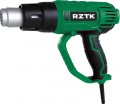Power consumption
The power normally consumed by the building dryer during operation. This parameter primarily determines the scope of the tool, as well as its performance, temperature and heating rate: more powerful models are better suited for large volumes of work, they produce a more intense air flow (see "Maximum Productivity") can be heated to higher temperatures and heating up is faster. At the same time, it must be taken into account that high power also has a downside: heavy weight, large dimensions and high cost of the tool, as well as a serious load on the power grid and significant electricity consumption. Therefore, when choosing by this parameter, it is worth proceeding from what work it is planned to use a hair dryer for and how important high power is for them. And don't forget about other features. After all, even the most powerful tool will be useless if it cannot provide, for example, the required temperature.
Weight
The total weight of the tool. On the one hand, heat guns are held in the hands during operation, which means that a lot of weight is undesirable for them — heavy devices are less “agile” and tyre the operator more. On the other hand, too little weight can mean low quality materials, a small thickness of insulation and, accordingly, unsatisfactory safety performance. Therefore, in most modern models, the weight is at least 500 g, and in the most advanced models it can exceed 1 kg. Also note that some "heavy" hair dryers may have a design that allows you to install them on a flat surface during operation.
If there are additional nozzles in the kit, the weight of the tool without them is usually indicated.

